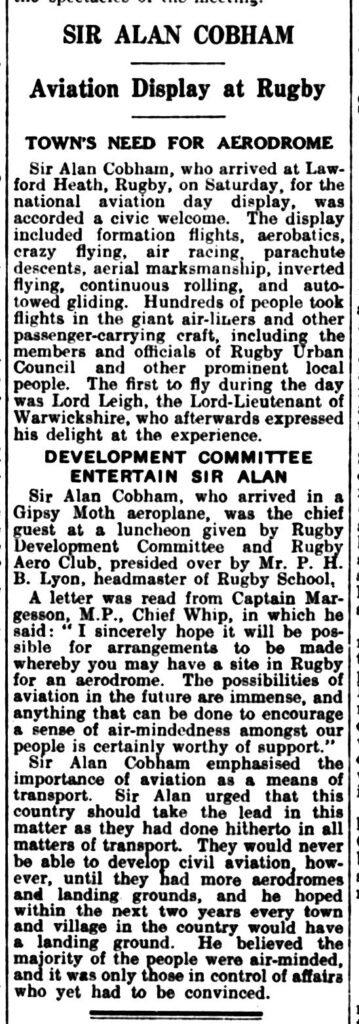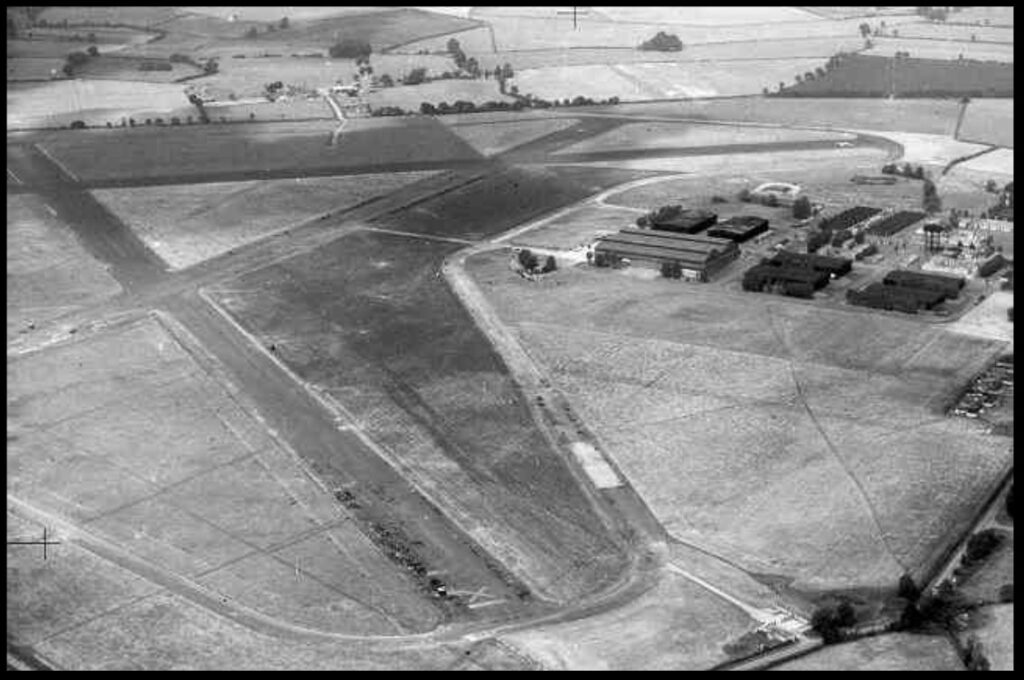Many will be aware of the existence of RAF Church Lawford during the war, and further details are provided below, along with details of the air activities prior to the war.
In 1932 there was an air display based at Lawford Heath organised by Sir Alan Cobham using a grass air-strip for public flights as well as various displays from aircraft that had flown in to the area. For many people this would have been their first experience of flying. Similar events were staged in 1933 and 1934. There is a suggestion that the airstrip was in a different to location to where RAF Church Lawford was to have an airstrip – this first strip being a mile to the north east.
The suggestion in the article below is that Rugby Councillors had a desire for Rugby to become home to an Imperial Airport – some 70 years before such a local possibility came to the fore again.


With the likelihood of war increasing in 1938, discussions began about the increased aerial threat to the country and the need for additional airbases. Many sites were chosen across the country with a wide range of strategic aim, with the impetus rapidly increasing when war was declared on 3rd September 1939. Obviously such discussions were not publicised, so precise details of the planning are difficult to find.
The local site chosen was to the south end of Church Lawford parish, bordering Long Lawford parish (Lawford Heath). This meant the farm and farmland at Ling Hall Farm was requisitioned.
Maps that illustrate the area chosen and the associated layout from the period can be found at the links below
These maps are referenced with the permission of the National Library of Scotland. These maps and more can be found via this link.
Flying at Church Lawford airfield began on June 15 1941 from a grass-surfaced runway, with three tarmac runways being laid in 1942. The primary focus of the airbase was as a training base, typically to train the instructors themselves, and the Central Flying School was located to Church Lawford from Cranwell. The main planes used were the twin-engined Airspeed Oxford, a noted training aircraft, along with the Avro Anson, although at times other aircraft were used, including the twin-engined Bristol Blenheim and the famous single-engine Hawker Hurricane.
A key training aim was to help familiarise pilots trained abroad with the terrain and weather conditions they could expect in Europe. As the base operated under black-out constraints it offered especially challenging conditions and a number of accidents occurred during night-flying. Other accidents occurred when planes collided with the nearby Rugby Radio Masts.
On April 5 1944 General Spaatz, commander of the US Strategic Forces in Europe landed at the airfield. That year also saw a number of Boulton Paul Defiant fighter aircraft stored at the airfield, possibly for a planned mission which did not occur. That year also saw one of the few enemy attacks on aircraft based at Church Lawford, with a Messerschmitt ME410 engaging with an unarmed training aircraft, but in that incident both aircrafts were lost, the German plane crashing in a field near Frankton.
RAF Church Lawford closed to active service on May 29th 1945, although training activities continued after the war until September 1946. For the following 20 years the base was used for storage of Airfield Construction equipment, with the area known as Church Lawford Aerodrome. The linked housing in Lawford Heath (part of Long Lawford Parish) continued to be used for married quarters for RAF personnel during those years.

The “OurWarwickshire” website has the above picture plus a view of the airfield when it had just a grass strip before the war – via this link.
In the latter part of the century, when the site was expected to revert to farming, it acquired a number of different uses as discussed here.
